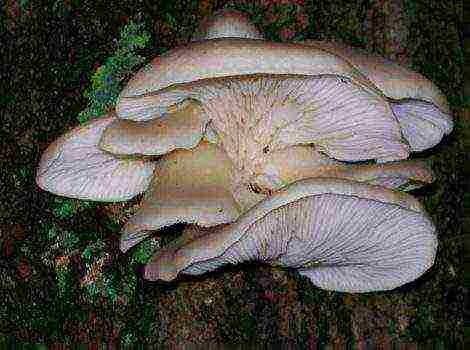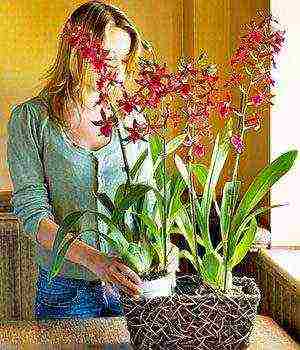Content
- 1 Wild garlic growth cycle
- 2 How to grow wild garlic at home
- 3 Ramson growing from seeds: when to plant?
- 4 Ramson: planting seeds at home
- 5 Propagation of wild garlic by seeds
- 6 Planting bulbs
- 7 Culture care
- 8 Ramson at home
- 9 Diseases and pests typical for the plant
- 10 Harvesting and storage
- 11 Harvesting and storage
Now is the time to start preparing for growing wild garlic at home. Growing wild garlic in a pot is not as easy as cultivated varieties of garlic. Native to the "lily of the valley with the aroma of garlic" is considered to be the North American mountain slopes, shady and damp litter of deciduous forests. The wild garlic appears in the spring as one of the first plants, covering whole carpets of greens smelling of garlic.
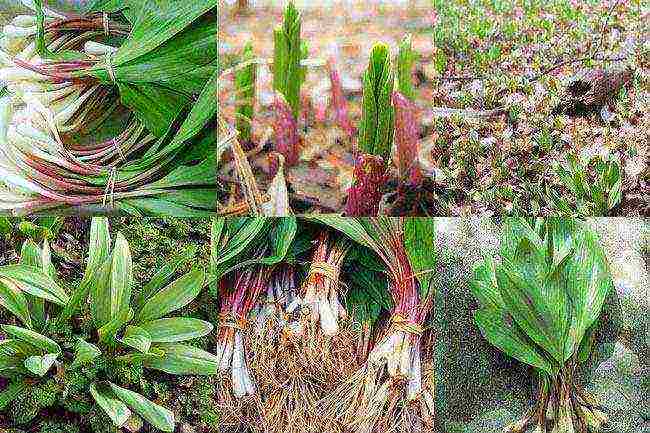
They began to cultivate wild garlic not so long ago. In Western restaurants, demand for it increased and the collection of wild garlic in the forest began to threaten this type of plant. Now being researched at universities, agrobiologists are working on practical methods for growing wild garlic under controlled conditions. I do not have the opportunity to collect it in the forest, so next season I will try to grow some wild garlic at home.
Wild garlic growth cycle
Ramson grows under the canopy of beech, birch, maple, poplar, oak and linden forests. The plant likes among nettle, Potentilla, ginseng.

Seeds germinate in March and early April in cool, shaded places with high humidity, abundantly rotting foliage and organic-rich soil. As the temperature rises, wild garlic sheds a leaf and by June throws out a stem with a flower. The seeds ripen by September. Unfortunately, such conditions cannot be created in the garden on the windowsill.
How to grow wild garlic at home
If it is difficult to grow wild garlic in the garden, but it is possible, then performing this feat in a pot on the windowsill is a real challenge. Ramson needs a shaded place, under fruit trees in a garden setting. And how to create similar conditions for her at home?
It is much easier to grow wild garlic from bulbs than from seeds, but I don’t know where I can get these bulbs. We are not looking for easy ways, we will grow wild garlic from seeds.
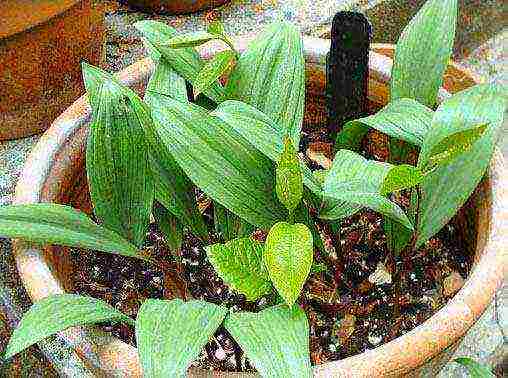
Stratification of wild garlic seeds
Wild garlic seeds require mandatory stratification at temperatures up to 0 ° + 3 ° C, for at least three months. Seeds should be no older than last year's - they deteriorate very quickly. Since the seeds lie for a long time, they need to be stratified in wet sand. Perhaps a glazed loggia is also suitable, on which the temperature does not drop below zero.
Soil preparation
A forest land with a rotten leaf would be ideal. Garden soil under a pear or apple is also suitable. The main condition is a lot of humus, organic matter, the soil must breathe and be well moistened. If there is no way to bring land from the forest, then the purchased soil must be flavored with organic fertilizer or compost. Prepare a dead leaf for mulching or any organic mulch - bark, larger sawdust, wood chips. Do not take coniferous waste, only fruit or deciduous.
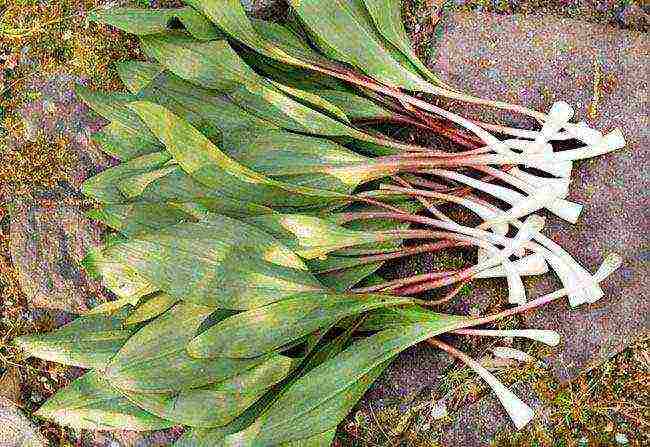
Sowing wild garlic
After stratification, we sow the seeds, preferably in containers or spacious deep pots. In the first year we will try to grow the bulbs for the next season. The land must be moist.We fill the container by two-thirds, distribute the seeds over the surface in 10 cm increments, sprinkle with a thin layer of soil and moisten from a spray bottle. We mulch, cover with foil, but with openings for air access. We hide in a dark cool place. In a couple of weeks, we are looking for a warmer place, but without access to sunlight. As soon as shoots appear, place containers with wild garlic under the windowsill away from direct rays.
After two seasons, the roots of the bulb will drop to 20 cm, this must be taken into account when choosing a container for planting wild garlic.
Watering
The soil for wild garlic should always be moist. I prefer to use a spray bottle for such specific plants, moisture lovers, during the day, I try not to flood, but also not to leave the surface dry.
Harvesting
The first season of wild garlic will serve you as an ornamental plant, we will begin to cut the greens only the next year, it is recommended to even endure 2 years with the harvest.

When harvesting, try to cut a leaf from the bush so that the wild garlic bulb can receive nutrition and grow stronger, because the plant is perennial and the harvest for the next season will depend on the bulb.
Wintering
As soon as the wild garlic has faded (this does not always happen in the first year), and all the leaves have come off, you can pack the container in perforated film and put it in a dark, cool place. A container with wild garlic bulbs should not freeze and the earth should dry out.

Reproduction
After 2-3 years, the wild garlic bulbs can be dug up and the bushy plants can be divided. If flowering at home is successful, you can harvest your seeds for further propagation.
Ramson or wild onion is a very useful perennial plant that is valued for its large amount of vitamins and nutrients. Ramson and its cultivation from seeds are of interest to all supporters of a healthy lifestyle, because eating leaves, bulbs, shooters has a positive effect on the work of the digestive and endocrine systems. Tips for growing wild garlic at home can be found in the article.
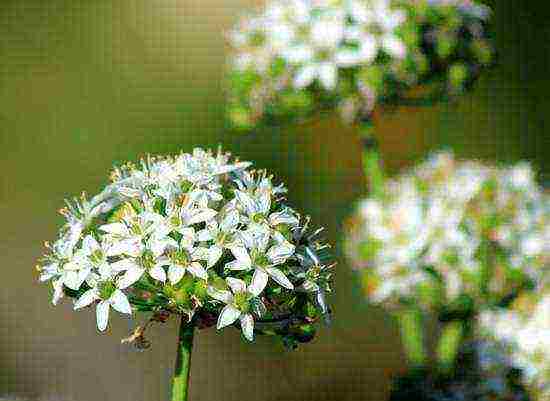
Ramson or wild onion is a very useful perennial plant that is valued for its high amount of vitamins and nutrients
Ramson growing from seeds: when to plant?
According to the reviews of successful summer residents, it is not difficult to grow wild garlic in the country, the main thing is to create natural conditions for the plant in which it usually grows. Wild onions can be found in nature in Altai, Siberia and the Far East. It grows in areas of light shade. Ramson loves moisture and calcium soils. Knowing these features, the summer resident will receive a large amount of fresh herbs.
Wild garlic seeds sprout when planted in well-heated soil. When the air temperature reaches +18 degrees, it's time to start sowing. Summer residents recommend sowing wild garlic in late April - early May, or already at the end of summer - in August, September. In spring, wild onions take root well and produce excellent shoots. In order for wild garlic to delight the summer resident with juicy, delicate greens, it is important to create optimal growing conditions for the plant, namely:
- the area for planting wild onions should not be too sunny. The plant does not like to grow in the shade. Under the influence of sunlight, the leaves of wild garlic become hard and small. The penumbra is just the perfect place to plant seeds. For example, you can organize a bed in the back of the garden;
- wild garlic is a crop demanding watering. At the same time, do not overmoisten the soil, otherwise the roots will begin to rot. You can water wild garlic every day. However, the ground should be easily permeable. To do this, you can provide drainage or dig up a section of sand before planting;
- the soil for planting should be slightly acidic, loose. It is recommended to mix it with humus.
In order for wild garlic seeds to sprout well in spring, it is important to carry out a stratification procedure before planting. For this purpose, they are kept in the refrigerator for a month or more, in a vegetable store.In April - May, you can start sowing. Self-collected seeds germinate well.
Ramson: planting seeds at home
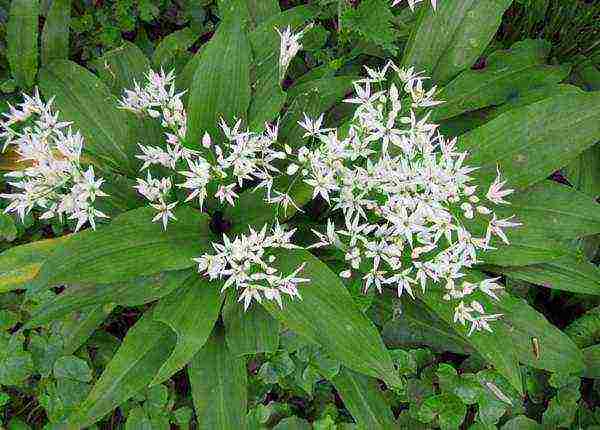
Ramson and its cultivation from seeds are of interest to all supporters of a healthy lifestyle, because eating leaves, bulbs, shooters has a positive effect on the work of the digestive and endocrine systems
After carrying out pre-planting seed preparation, choosing a planting site, you can start sowing the material. To do this, make grooves up to 5 cm deep on the site, where seeds are sown, previously mixed with sand. This makes it easier to control the crops. After the garden bed is moistened.
You can also grow wild garlic at home in a regular flower pot. A deep flowerpot is suitable, since the wild garlic bulb develops at a depth of about 20 cm. After stratification, the seeds are sown in a container with soil, sprinkled on them, moistened with a spray bottle. The container is covered with a transparent film and sent to a dark, cool place. After 2-3 weeks, it is recommended to place the seed pot in a warm, but not sunny place.
Wild onions grow well in moist soil. Watering is recommended daily using a spray bottle. It is recommended not to cut the leaves in the first year after planting wild garlic. Let the plant grow strong and grow well. In the fall, when the wild garlic has faded, it is sent for storage in a dark, cool place. However, from time to time, the plant should be taken out and moistened.
3 years after sowing the seeds, wild garlic bulbs will develop in the flowerpot, which can be used to propagate the plant. The ramson are carefully dug up, the bulbs are separated and planted in open ground or transplanted into other deep containers.
Growing wild garlic from seeds at home, video:
Ramson, growing from the seeds of which is described in the article, is troublesome, but very exciting. Wild onions bloom beautifully and are often grown as an ornamental plant. However, eating the bulbs and the aerial parts is very beneficial for health, because wild garlic is a storehouse of vitamins and microelements. Have you managed to grow wild garlic at home? We invite you to share your experience in the comments.
(
estimates, average:
out of 5)
 The representative of the onion family - wild garlic - won the love of gardeners-summer residents with its spicy aromatic properties. This is actually a wild plant, but it is also available for growing in a personal plot. The article will tell you how to plant this plant with seeds, as well as how to harvest it in your country house.
The representative of the onion family - wild garlic - won the love of gardeners-summer residents with its spicy aromatic properties. This is actually a wild plant, but it is also available for growing in a personal plot. The article will tell you how to plant this plant with seeds, as well as how to harvest it in your country house.
Growing wild garlic: two methods
There are several types of ramson. However, most often this word refers to the variety Bear onion, which can be found in bunches on market shelves. This forest dweller looks like a lily of the valley, and tastes like garlic. The bulbs of wild garlic are oblong, about 1 cm in length. The stem is triangular, up to 40 cm high. In the forest, wild garlic protects itself from destruction: it grows in swamps or deaf often, fades before the start of haymaking. However, today the plant is still in the Red Book.
People appreciate wild garlic for its taste and healing properties, which is why there is a fashion for its cultivation on a personal plot. The process is simple. It is only necessary to take into account a few nuances. In dacha practice today, there are two ways to cultivate a bear onion:
- In shady gardens or in partial shade near outbuildings.
- In the beds next to vegetables and other plants.
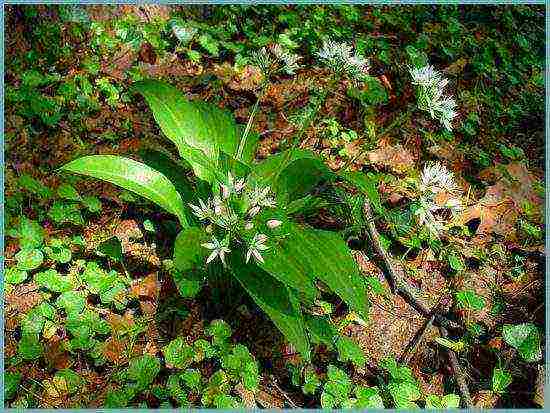
Wild garlic bush
The task of the first option is to reproduce the natural environment of wild garlic growth: in the shade, dampness, lowland - places where only weeds usually grow. The plant needs almost no care and gives a vitamin harvest in early spring. Growing garden bear onions requires fertile, neutral soil. The bulbs will be at a depth of 7-15 cm - the ground should be loose, airy. In this case, the shadow is optional.
Advice.Gardeners recommend making two plantings of wild garlic at the same time: in a shady place where the snow lies for a long time, and where it melts in the first place. Thus, you can harvest longer.
How to plant and grow wild garlic
The principle of growing wild garlic is similar to the cultivation of traditional perennial onions. It is possible to reproduce a plant when it reaches the age of 4 years. This is done by:
- seeds;
- bulbs.
The disadvantage of propagation with bulbs is that one shoot next year will replace only one plant. The bulbs take root in late summer - early autumn or mid-spring. The foliage is harvested after 3 years. If you intend to dig up the bulbs, break off the flower umbrella during the budding period, and then you will get larger tubers.
If you want to plant wild garlic with seeds, remember: after flowering (the plant throws out an umbrella of rounded white flowers), the fruit with the planting material will ripen in June-July. You can collect seeds in the forest, but, firstly, it is not easy to find the place where wild garlic grows, and secondly, it is illegal due to the fact that it is in the Red Book. Ideal seeds are those that have ripened, but have not yet crumbled.
Advice. The shell of bear onion seeds hardens quickly, so they must be germinated freshly harvested. Otherwise, they will lose germination. It is rational to buy them from mid-summer to autumn. Read the packing date carefully.
Seeds can be immediately planted in mulched soil - they will appear by September, or sow them before winter. You can also do this after stratification at t 0 ... -3 ° C for 80-100 days. The first year of wild garlic should be spent in a box. On the second, it can be planted in the ground, deepening by 0.5-1 cm.
For the plant to take root in the soil, choose a place that warms up well in spring. Keep the soil from drying out all year round. The plant will sprout in the coming spring. You can cut the leaves in 5 years.
Attention! Seeds sown in spring after stratification will sprout only after a year. For this reason, it is worth planting them in containers before winter.
How to care for wild garlic and harvest
Growing bear onions requires patience. Annual wild garlic is a small sprout with one leaf, two-year old is slightly larger in size. An adult plant is a small bush with several leaves. A normal harvest in one place, a bear onion is capable of producing no more than 7 years.
There are no innovative techniques in plant care:
- water frequently;
- loosen the ground;
- keep plantings clean;
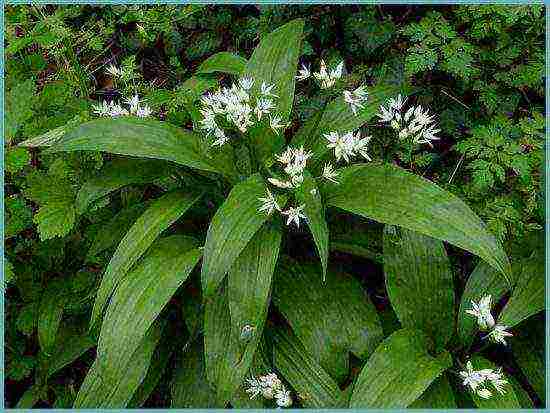
Ramson does not require special care
- get rid of the weeds;
- fertilize wild garlic with mineral dressings and organic matter.
Moreover, in the first year or two, this will not be needed either. After the completion of the growing season, mulch the beds with peat, divide the bush and transfer to a new site.
Advice. When plucking the leaves, try not to damage the inflorescences. The seeds in them will ripen, fall nearby and increase your "plantation" next year.
When the wild garlic grows to cut the leaves, start doing this immediately after the snow melts. Collect the arrows last - until the seeds of the plant become milky-waxy. Arrows are superior to leaves in taste and are perfectly pickled. Pluck bear onions in May, remembering to leave the bulbs in the soil. Leaves should be collected no more than once every two or three years, and in no case should you touch everything at once. The bulbs for further harvesting should be dug up in late autumn.
Like cultivated onions, wild garlic can be grown in jars or pots in winter. To do this, plant the bulbs at the end of October: the harvest will be already around the Christmas holidays. Difficulty growing and long waiting times will be rewarded with the first spring greens on your table.
Ramson: video
Growing wild garlic: photo
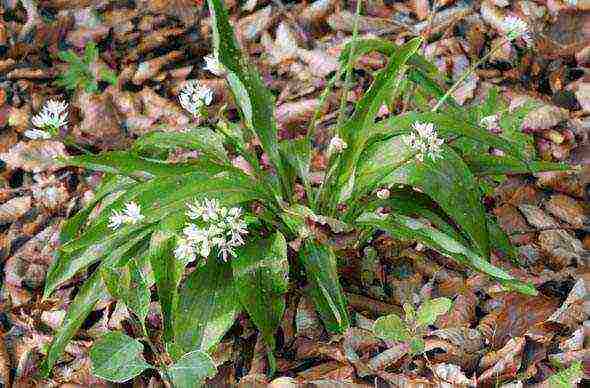

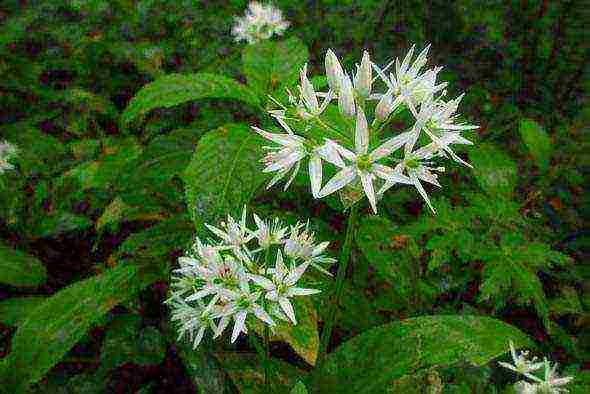
In nature, wild garlic is found everywhere in the Northern Hemisphere. You can also grow it on personal plots.The plant is extremely unpretentious, caring for it is very simple. Greens can be cut much earlier than other herbs, it is a source of vitamins and minerals, which is especially valuable in the middle of spring after winter beriberi. The culture is widely used both in cooking and in folk medicine. Leaves of wild garlic are wide and flat, very similar to the leaves of lily of the valley. And it tastes like a cross between onions and garlic.
Propagation of wild garlic by seeds
Wild garlic breeders are not yet particularly interested in it, although several varieties can still be found in stores. At the same time, due to deforestation, the plant in many regions is listed in the Red Book, because its natural habitat is irreversibly damaged. The names of the new varieties do not differ in originality and creativity of the approach - Bear cub, Bear ear, Bear delicacy, Bear paw. At the same time, wild garlic is often called "bear onion", and the glades on which it grows are called "bear meadows". This nickname is due to the fact that when the bears come out of hibernation, wild garlic is practically the only fresh greenery in the forest. Therefore, the animals are happy to feast on young shoots.
 The choice of wild garlic seeds in specialized stores cannot be called very wide.
The choice of wild garlic seeds in specialized stores cannot be called very wide.
Video: what wild garlic looks like
You can also collect seeds yourself. Practice shows that about every tenth plant in the garden blooms every year. Inflorescence in the form of an almost regular ball consists of small white flowers. Round black seeds ripen in the second or third decade of June in triangular "capsule" fruits. They are cut off when they start to turn yellow. Then the shell will harden and it will be very difficult to open it without damaging the planting material for the next season. The seeds are poured out of the "box", dried and stored in a cool, dry, dark place with good ventilation in paper bags or linen bags before planting. The “harvest” is 100–120 seeds per plant.
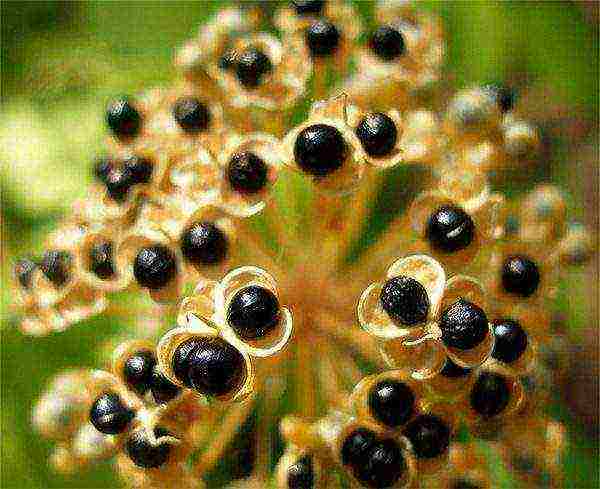 Collecting wild garlic seeds yourself, you can be sure of their freshness
Collecting wild garlic seeds yourself, you can be sure of their freshness
When buying, be sure to pay attention to the expiration date. They should be harvested last summer, not earlier. Older ones do not differ in germination. You can also distinguish them in appearance - they are not black and rounded, but grayish and wrinkled.
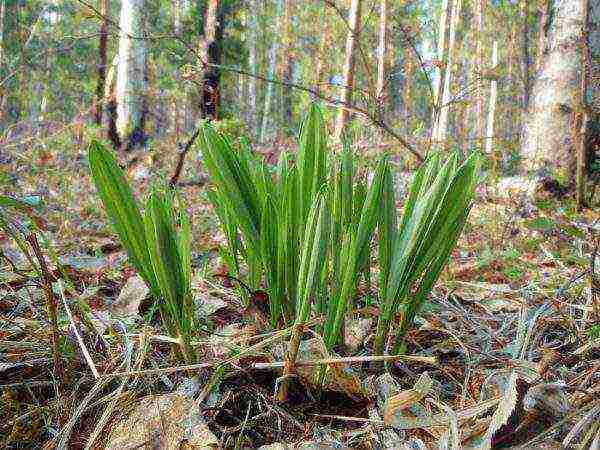 In spring, young shoots of wild garlic appear practically from under the snow
In spring, young shoots of wild garlic appear practically from under the snow
The site chosen for planting seeds is dug up in advance to a depth of 40–50 cm (the roots of the plants are quite powerful). Weeds and other plant debris are removed at the same time. Slaked lime, dolomite flour or eggshells crushed to a powder state (200-300 g per linear meter) are added to the acidic soil. You can also use wood ash - it is not only a good deoxidizer, but also saturates the soil with potassium and phosphorus. About two weeks before planting, the bed is loosened, applying organic fertilizer to increase soil fertility. Humus, rotted compost will do. But it is undesirable to use fresh manure and droppings. Such a powerful agent can "burn" the roots of the emerging seedlings.
 Humus is an effective remedy for increasing soil fertility
Humus is an effective remedy for increasing soil fertility
Most gardeners practice autumn planting of wild garlic seeds, doing it in the first decade of September. The latest possible date is mid-October. The specific time is chosen based on the climatic conditions in the region. The optimum temperature for them is about 20 ° C. If it exceeds 25–26 ° C or below 10 ° C within a month after planting, the gardener will, at best, wait for single shoots.
Before planting, the seeds must be stratified, imitating hibernation. They are mixed with sand or peat, moisten the substrate and send the container for 80–100 days to a refrigerator or other place with a constant temperature of 0–3 ° С.Another option is to wrap the seeds in a wet cloth or paper towel, place it in a glass jar, and roll up the lid. The substrate is moistened as necessary. Usually once a week is enough. Periodically they need to be shaken up, providing fresh air access.
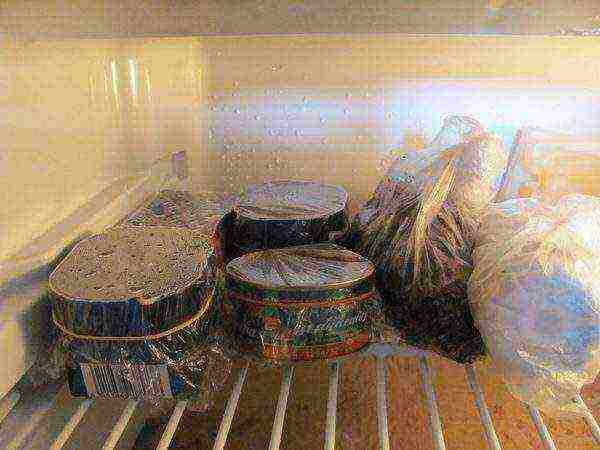 Seed stratification imitates their "wintering" in natural conditions
Seed stratification imitates their "wintering" in natural conditions
Video: Seed Stratification
To increase germination, seeds are soaked for 12-14 hours in a solution of any biostimulant. The same effect is given by both purchased preparations (Epin, Zircon, Emistim-M, Kornevin) and folk remedies (aloe juice, succinic acid, honey diluted with water).
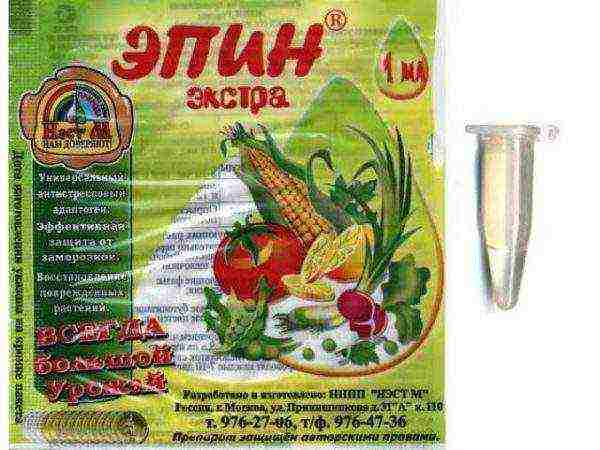 Epin, like other biostimulants, helps to increase seed germination, and treatment has a positive effect on plant immunity
Epin, like other biostimulants, helps to increase seed germination, and treatment has a positive effect on plant immunity
Seeds are sown in grooves 4–5 cm deep. Row spacing is about 20 cm. Sow them as evenly as possible, sprinkle them with humus mixed with fine sand on top. It is undesirable to use peat crumbs, it strongly acidifies the soil. Then the bed is tightened with plastic wrap.
The first shoots will appear in the spring, somewhere in April, but not next year, but after another season. That is, the whole process takes about one and a half years. As practice shows, no more than a third of the seeds germinate. Immediately after this, the shelter will need to be removed. When one real leaf is formed, the plants are planted, leaving 15–20 cm between them. This is done very carefully, removing them from the soil together with a lump of earth. The root system of young seedlings is very fragile. They are buried in the soil by a maximum of 5 cm. During the first two seasons in the open field, it is advisable not to disturb the plants by cutting off the leaves. It is better to give them the opportunity to form a developed root system. The plantings are looked after, regularly weeding the beds, very carefully loosening the soil and watering them.
 Seedlings from wild garlic seeds have to wait long enough
Seedlings from wild garlic seeds have to wait long enough
If there is a shortage of planting material, the seeds are planted in small peat pots filled with universal soil for seedlings or a mixture of humus with fertile turf. These containers are buried in the ground.
Another way of planting wild garlic seeds is using the so-called nursery. A shallow box is dug into the ground in a greenhouse or outdoors. Seeds are sown according to the scheme 0.5 * 0.5 cm. Two years later, when the seedlings grow up and get stronger, they are planted, transferring to a permanent place. This avoids "crowding" in the garden.
Spring planting is also possible. The procedure is best planned in April. In this case, the bed is tightened with any air-permeable white covering material (agryl, lutrasil, spunbond). Seedlings appear in May-June next year.
Ramson reproduces quite successfully by self-sowing, therefore, after a while, the plantings in the garden become very thickened, the plants no longer have enough space to feed. To avoid this, every five years, large groups of bulbs are separated and planted, transferring to new places. In the same way, the plant can "creep" over the site, turning into a common weed. Therefore, it is recommended to surround the bed with slate sheets dug around the perimeter.
Video: growing wild garlic from seeds
Planting bulbs
Ramson is not picky, but in order for the plant to feel better and bring a good harvest, it is advisable, if possible, to recreate the natural conditions of its habitat. In nature, wild garlic grows in forests, along the banks of swamps, streams, springs. The plant is not tall (20-50 cm), so trees and shrubs shade it. Accordingly, it is best to plant it on a garden plot in the shade of a building, structure, fence, under a fruit tree, and so on. The culture does not like the bright sun - the leaves become smaller, lose their juiciness, dry out, the taste becomes less pronounced. For the gardener, this feature of the plant is an advantage - you can save space on the garden plot.In addition, a garden bed located in an open place will have to weed and water much more often.
 For wild garlic in a garden plot, you can take a place that, due to shading, is not suitable for most other crops
For wild garlic in a garden plot, you can take a place that, due to shading, is not suitable for most other crops
The wild garlic does not have any special requirements for the quality of the soil. It successfully takes root in both "light" sandy and "heavy" clay soils. The only thing that the plant does not tolerate categorically is an acidic substrate. The best option for him is loose soil that allows air and water to pass through well. In nature, wild garlic grows almost in a swamp, but in captivity it does not like waterlogging. It is especially dangerous in early spring - the bulbs almost inevitably rot. Therefore, it is not recommended to plant wild garlic in the lowlands. There is melt water for the longest time. If there is no alternative, it is imperative to take care of drainage by adding crushed stone, expanded clay, pebbles to the soil. Or you have to fill in ridges about half a meter high.
Gardeners often resort to propagation of wild garlic with bulbs. This method allows you to quickly get a harvest from a new plant. But it is not devoid of certain drawbacks - only one new ovary is formed from each shoot. The optimal time for the procedure is August-September, when the vegetative period has already ended and the plant has “fallen into hibernation”. The above-ground part dries up and dies off by this time, so the specimens intended for division must be marked in advance, otherwise you simply will not find them in the garden. The gardener will receive the first harvest when using this method of propagation in the third year of the life of a new plant.
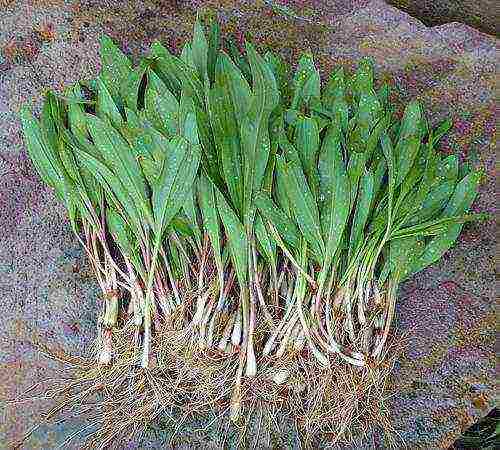 New wild garlic bulbs are formed annually
New wild garlic bulbs are formed annually
If there is a shortage of planting material, several bulbs can be planted in an open, sunny place, and not in the shade, as usual. Such plants develop faster and "divide" much more actively, but they need more careful care, especially with regard to watering and weeding.
The bulbs are planted in the same way as the seedlings, leaving 15–20 cm between the plants. They are buried in the ground by a maximum of 5 cm, the smallest ones - by 2–3 cm. Dry “feathers” should be visible on the surface. Planting is moderately watered, the soil is mulched with freshly cut grass, dead leaves, wood chips, creating a layer 5–7 cm thick. It is undesirable to use fresh sawdust for this, especially conifers. The substrate is quickly acidified. Whether the procedure was successful can only be judged next fall after the transplant. If all goes well, a new replacement bulb should form. The aerial part of the plant practically does not develop during the summer; it pays the main attention to the roots.
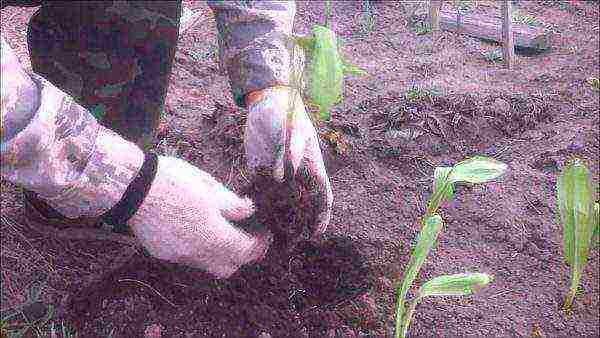 The wild garlic bulbs are transplanted very carefully so as not to damage the plant roots
The wild garlic bulbs are transplanted very carefully so as not to damage the plant roots
Practice shows that wild garlic bulbs gradually go underground. The largest and oldest are located at a depth of 20-25 cm. Dig them out very carefully so as not to damage the roots of neighboring plants. In the case of the "children" taken out of the earth, they are unwound by hand whenever possible, cutting only where it does not work out at all. It makes no sense to plant bulbs without roots at all or with dry roots. They won't take root.
 The wild garlic bulbs extracted from the ground must have roots, otherwise there is no point in replanting them
The wild garlic bulbs extracted from the ground must have roots, otherwise there is no point in replanting them
The garden bed is prepared in advance by digging deep into the soil. In addition to humus (3–5 l / m²), nitrogen (15–20 g / m²), potash (10–15 g / m²) and phosphorus (25–30 g / m²) fertilizers are also added. Suitable, for example, urea, simple superphosphate and potassium nitrate. There are also complex dressings containing these macronutrients - Azofosk, Nitrofosk, Diammofosk.
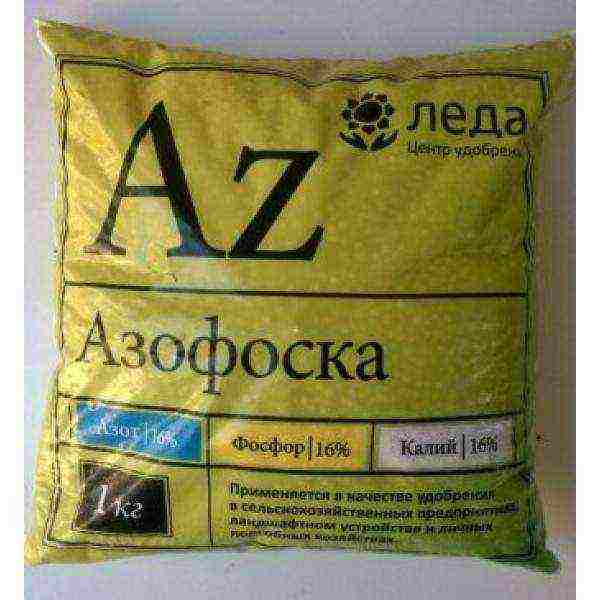 Azofoska is a complex fertilizer containing nitrogen, phosphorus and potassium
Azofoska is a complex fertilizer containing nitrogen, phosphorus and potassium
It is not worth constantly growing wild garlic in the same place. Plants begin to ache and wither. It is recommended to transfer the culture to a new bed every 7–8 years. A clear signal that it's time is thinning stems, shrinking leaves and bulbs.
Culture care
The plant is extremely unpretentious, it needs only minimal maintenance. Particular attention should be paid to watering wild garlic. The soil in the bed should be constantly moderately moist, especially in the first month after transplanting to a permanent place. But you can't fill the plant either - the bulbs will rot and it will die.
The best option for wild garlic is frequent but moderate watering. The soil between them should dry out 4–5 cm deep. This can be easily determined by digging a small hole in the garden bed and trying to compress the soil into a ball. If it crumbles in your fingers, it's time to water. When the weather is cool, cloudy, it is enough once every 4-6 days, in heat and with prolonged drought, the intervals between watering are halved.
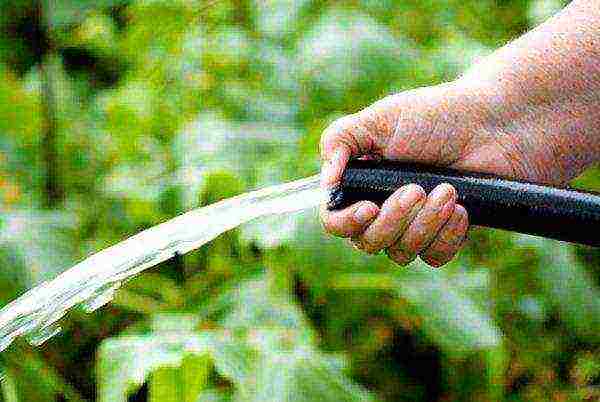 Proper watering is the main component of competent care for wild garlic
Proper watering is the main component of competent care for wild garlic
Ideally, loosen the soil after each watering. If it doesn't work out, then at least 2-3 times a month. This improves the aeration of the soil and provides the roots with oxygen and nutrients. In such a soil, water does not stagnate.
After the aboveground part dies off, you can forget about watering. Until next spring, the plant will have enough natural rainfall.
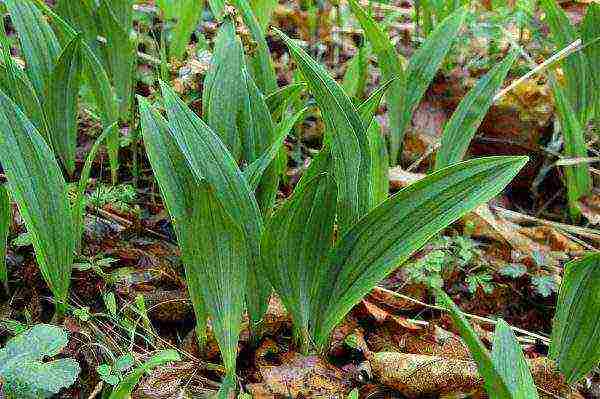 Mulching a garden with wild garlic helps the gardener save time on weeding and reduce the number of waterings
Mulching a garden with wild garlic helps the gardener save time on weeding and reduce the number of waterings
Another important point is weeding. Mulching will help significantly save time on it (as well as retain moisture in the soil by increasing the intervals between watering). The optimum layer thickness is 3-4 cm. It will have to be renewed as necessary. The hardest damage to the plantings of wild garlic is wheatgrass and sow thistle. These weeds have strong roots that can pierce the bulbs through and through, destroying the plant.
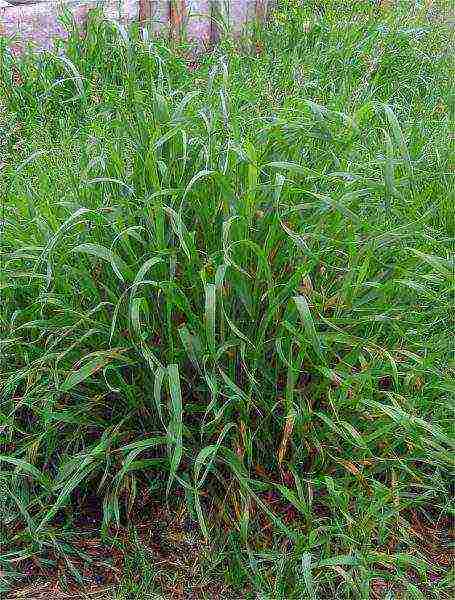 Wheatgrass rhizomes can seriously damage the wild garlic bulbs, so weeding the beds is a must
Wheatgrass rhizomes can seriously damage the wild garlic bulbs, so weeding the beds is a must
The vegetative period for wild garlic is rather short, therefore, from fertilizers it is better to give preference to natural organic matter or purchased products based on vermicompost. The plants are fed with infusions and solutions every 3-4 weeks. The frequency of application of store fertilizers and the concentration of the solution are determined by the instructions given in the manufacturer's instructions.
Once every two years, in the spring, in order to increase the fertility of the soil, humus or rotted compost (2-3 l / m²) is embedded in the soil during the first loosening. You can also apply nitrogen-containing fertilizers (urea, ammonium nitrate, ammonium sulfate) in dry form or in the form of a solution (8-10 g per 1 m² or 10 l of water). You should not overdo it with such dressings. An excess of nitrogen in the soil has a bad effect on the immunity of plants, the leaves darken, become coarser, and nitrates harmful to health accumulate in them. And at the end of the growing season, sifted wood ash is annually scattered over the garden bed (glass per 1 m²). It is a natural source of potassium and phosphorus. Dolomite flour or other substance with similar properties is added to acidic soil every 3-4 years.
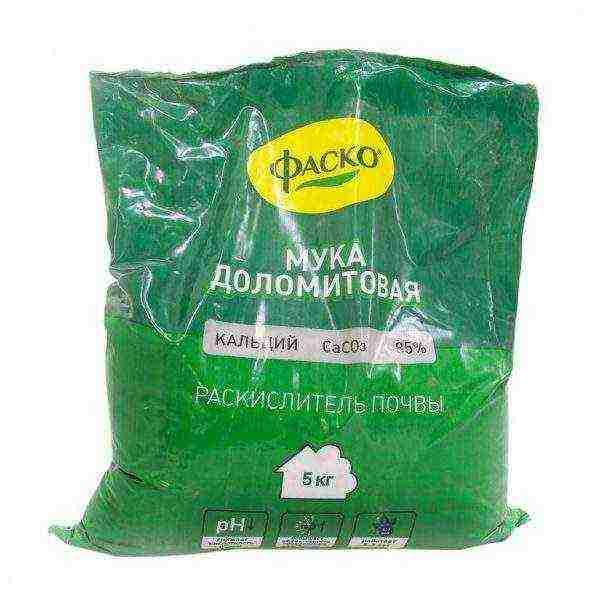 Dolomite flour is a soil deoxidizer that has no side effects if the recommended dosage is observed
Dolomite flour is a soil deoxidizer that has no side effects if the recommended dosage is observed
For feeding wild garlic, infusions are prepared from fresh cow dung, bird droppings, nettle greens, dandelion leaves. In principle, any other weeds growing on the site can be used. A deep container is filled with raw materials by about a third, top up with water, and tightly closed. Then it is left in the sun for 3-4 days until a characteristic odor appears. Before use, the finished fertilizer is filtered and diluted with water in a ratio of 1:10 or 1:15 if droppings were used as raw materials.
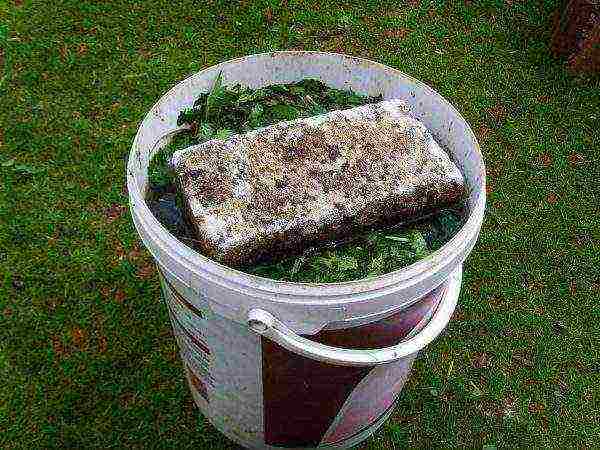 Nettle infusion is an absolutely natural and completely free fertilizer
Nettle infusion is an absolutely natural and completely free fertilizer
Wild garlic hibernates, as a rule, without additional shelter, even in regions with a temperate climate. But if the winter is expected to be very harsh and at the same time with little snow, it is advisable to insure yourself by covering the bed with a layer of mulch (fallen leaves, needles, straw) 8-10 cm thick and tightening with several layers of burlap or other covering material that allows air to pass through. As soon as enough snow falls, it is thrown from above, building a snowdrift. It gradually settles, so during the winter you will have to renovate the structure several times.
Video: tips for growing wild garlic
Ramson at home
The dimensions of wild garlic do not differ, so it is quite possible to grow it at home, providing yourself with fresh healthy greens all year round. The height of the plant is only 20-50 cm, the leaves are narrow, 3-5 cm wide, there are few of them in the outlet. The best time to disembark is early spring. Many people believe that the greens in "captivity" are softer and juicier than in the garden.
With a not too high plant height, the root system of wild garlic is quite powerful, the bulbs are in the soil at a depth of about 20 cm. Therefore, the pot for her is chosen not too wide, but deep, resembling a bucket in shape. Preference is given to ceramic containers without glaze coating. Such material allows air to pass through better, preventing moisture from stagnating at the roots.
 The pot for growing wild garlic must be deep enough
The pot for growing wild garlic must be deep enough
A universal soil for indoor flowers is suitable for the plant, but it is better to mix the soil yourself. Humus, leafy sod land and coarse river sand should be taken in a 2: 2: 1 ratio. You cannot take turf from under coniferous trees. In nature, wild garlic never grows under them. To prevent the development of rot, for every 3 liters of the finished substrate, put a tablespoon of powdered chalk or activated carbon.
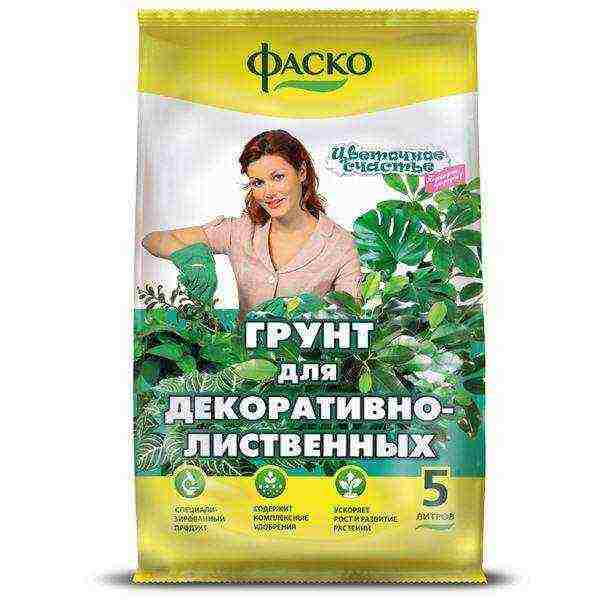 The garlic is undemanding to the quality of the soil, this also applies to those specimens that are grown at home
The garlic is undemanding to the quality of the soil, this also applies to those specimens that are grown at home
Both the pot and the soil must be sterilized before planting. The container should be thoroughly washed and rinsed with boiling water, the soil is frozen, steamed, fried in the oven or spilled with a dark purple solution of potassium permanganate.
You can plant both seeds and wild garlic bulbs at home. For the first, pre-planting preparation is required. The procedure is no different from that described above for open ground. But at home, seedlings appear much faster, after about a month.
After planting, the seeds and bulbs are sprinkled with a layer of fine sand mixed with peat chips (layer thickness - 5–7 cm). The soil in the pot is moderately moistened by spraying with a spray bottle. The container is tightened with plastic wrap or covered with glass. The "greenhouse" is opened daily for ventilation for 8-10 minutes, preventing condensation from accumulating. The substrate is gently loosened, moistened as it dries. As soon as shoots appear, the pot is transferred to a place where it will be provided with light partial shade and protection from direct sunlight.
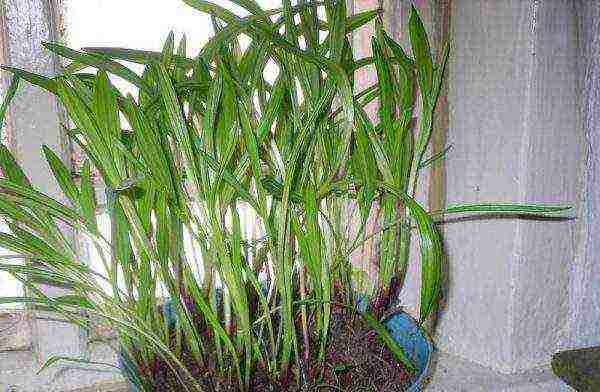 There is nothing difficult in growing wild garlic at home
There is nothing difficult in growing wild garlic at home
For the summer, it is useful to take wild garlic to the balcony, open veranda, terrace. The plant reacts very positively to fresh air. Caring for her consists in regular watering and feeding. Any complex means for decorative foliage will do. You can alternate them with natural organic matter and fertilizing based on vermicompost.
The first harvest at home is obtained in two years if wild garlic seeds are planted. From the bulbs - for the next season. Too zealous with cutting is not worth it, the plant may not recover from a sharp loss of most of the green mass. It is recommended to have several copies at once and "cut" them one by one.
Diseases and pests typical for the plant
The specific smell of wild garlic and the high concentration of essential oils in the leaves repel the vast majority of pests that feed on plant juices. Perhaps the only exception is the miner fly. Cultural immunity is also pretty good. Most often, various types of rot are manifested, in the development of which the gardener himself is often to blame, too often and / or watering the plant abundantly. Another possible fungal disease is leaf rust. It is most often transmitted from crops growing nearby.
The main danger for wild garlic is not the adult specimens of the miner fly, but its larvae. They penetrate the tissue of leaves and eat out “tunnels” in them, practically without leaving the surface.Outside, it looks like semicircular bulges with a diameter of about 1 mm and a length of 1.5–2 cm. Associated symptoms are discolored tissue areas that gradually become thinner and die off, deformed withering leaves. This process is usually going on rather quickly.
 For some reason, the miner fly is very partial to the yellow color, this feature is used in the manufacture of homemade traps
For some reason, the miner fly is very partial to the yellow color, this feature is used in the manufacture of homemade traps
You can fight with adults by hanging sticky tape for catching flies or homemade traps next to the garden bed - cut plastic bottles filled with sugar syrup, diluted honey or jam, or pieces of cardboard, plywood, linoleum, greased with the same honey, petroleum jelly, long-drying glue ... The larvae are scared away by sprinkling the soil in the garden with a mixture of wood ash, tobacco chips and ground red pepper.
 Miner fly larvae eat leaf tissue from the inside
Miner fly larvae eat leaf tissue from the inside
When characteristic damage is found, insecticides are used - Aktaru, Konfidor-Maxi, Mospilan, Apache. The frequency of processing and the concentration of the solution are determined by the instructions. You need to spray both the plants themselves and the substrate.
Rust is caused by a fungus that is carried by the wind or carried by droplets of water. In the affected plant, the normal course of the process of photosynthesis and metabolism is disrupted, it suffers from a moisture deficit, the leaves gradually fall off. At the same time, depressed red spots of a rounded shape appear on the front side, the wrong side is tightened with a continuous layer of "fleecy" plaque of a saffron shade. Gradually, it changes color to a rusty brown and thickens.
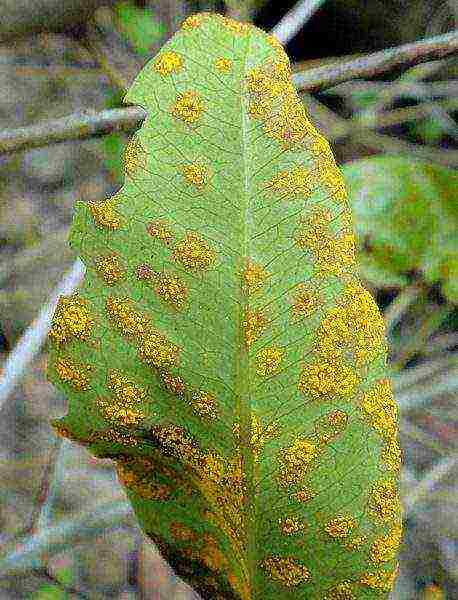 Leaf rust is a dangerous disease that disrupts the processes of photosynthesis and metabolism that are vital for the plant.
Leaf rust is a dangerous disease that disrupts the processes of photosynthesis and metabolism that are vital for the plant.
For prevention in early spring, the soil in the garden is sprayed with a 5% carbamide solution, and at the end of the growing season, it is treated with 2% copper sulfate. During the period of active growth, once every 2-3 weeks, wild garlic is sprayed with foam of green potassium or laundry soap, a pale pink solution of potassium permanganate, diluted in water with soda ash or colloidal sulfur (15-20 g per 10 l). Effective folk remedies - diluted 1:10 kefir or milk whey with the addition of iodine (drop per liter). You can dilute ammonia or vinegar essence with water in the same proportion.
Fight disease with fungicides. It is advisable to choose drugs of biological origin (Ridomil-Gold, Alirin-B, Tiovit-Jet, Bayleton). More potent are Abiga-Peak, Topaz, HOM, Kuprozan. There are also means, the effectiveness of which has been tested by more than one generation of gardeners - Bordeaux liquid, copper sulfate.
 Bordeaux liquid is a common fungicide, the effectiveness of which has been tested by more than one generation of gardeners, you can do it yourself
Bordeaux liquid is a common fungicide, the effectiveness of which has been tested by more than one generation of gardeners, you can do it yourself
Gray rot in the vast majority of cases is caused by waterlogging of the soil. A grayish "dust" appears on the leaves, then brownish or beige "translucent" spots, as if watery. Gradually they turn gray and are covered with a continuous layer of "fluffy" plaque of ashy color with small black blotches. The affected areas of tissue soften and die off.
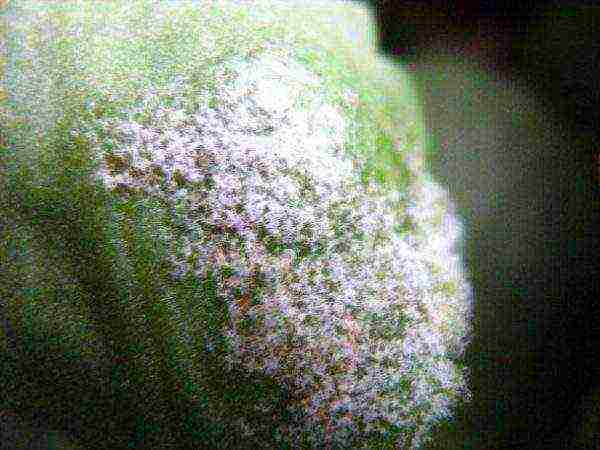 Most often, the gardener himself is to blame for the development of gray rot of wild garlic, who is too zealous with watering.
Most often, the gardener himself is to blame for the development of gray rot of wild garlic, who is too zealous with watering.
For prevention, the plants are powdered with crushed chalk or sifted wood ash, the soil in the garden is sprinkled with colloidal sulfur. Water for irrigation is periodically replaced with a pale pink solution of potassium permanganate.
If the disease is not noticed in time, the plant can only be dug up and burned to eliminate the source of the infection. At an early stage, all areas of the affected tissue are excised with a disinfected razor blade or scalpel. It is necessary to capture also 2-3 mm healthy in appearance. Most likely, the spores of the fungus have already spread there, just external symptoms have not yet appeared."Wounds" are washed with 2% copper sulfate and sprinkled with activated carbon powder or cinnamon. At the next loosening, granules of Trichodermin, Glyokladin are introduced into the soil. Instead of water for a month, wild garlic is watered with a bright pink solution of potassium permanganate or Fitosporin-M.
 Potassium permanganate solution is an effective means for soil disinfection
Potassium permanganate solution is an effective means for soil disinfection
Root rot is even more dangerous for the culture. It develops for a long time, not manifesting itself in any way on the aerial part of the plant. Then the bases of the stems soften, change color to black-brown, become slimy to the touch. The soil is covered with a layer of mold, an unpleasant putrefactive smell spreads. Fighting the disease at this stage is no longer possible. The plant is pulled out and burned, the soil in this place is disinfected by spilling with a 5% solution of copper sulfate. Preventive measures are similar to those used to protect against gray mold.
 It is almost impossible to notice the development of root rot at an early stage.
It is almost impossible to notice the development of root rot at an early stage.
Harvesting and storage
The crop is ready for harvesting almost as soon as the snow melts. The highest concentration of vitamins, minerals, essential oils, phytoncides and other healthy substances in the leaves of wild garlic is observed in April. But it should be borne in mind that the earlier the greens are cut, the more time it takes for the plant to recover. The bulbs, on the other hand, are dug up at the end of summer, when they reach their maximum size. Used as food and arrows. They are even softer and juicier than leaves. After flowering, which occurs in May, the harvest is stopped - the greens are noticeably coarse.
It is almost impossible to notice the development of root rot at an early stage.
Harvesting and storage
The crop is ready for harvesting almost as soon as the snow melts. The highest concentration of vitamins, minerals, essential oils, phytoncides and other healthy substances in the leaves of wild garlic is observed in April. But it should be borne in mind that the earlier the greens are cut, the longer the plant needs to recover. The bulbs, on the other hand, are dug up at the end of summer, when they reach their maximum size. Used as food and arrows. They are even softer and juicier than leaves. After flowering, which occurs in May, the harvest is stopped - the greens are noticeably coarser.
 The yield of wild garlic is very good, but you need to collect the leaves so that it is not to the detriment of the plants.
The yield of wild garlic is very good, but you need to collect the leaves so that it is not to the detriment of the plants.
The rosette of wild garlic, as a rule, consists of three to five leaves. You can cut (just cut, not pull out or twist) the top two or three. The lowest leaf necessarily remains on the plant so that it recovers faster the next year. In the current season, there will be no new greenery. Adult specimens from the age of five can be cut completely. The yield of wild garlic is not bad - about 1.5 kg of green mass is obtained from 1 m². In adult plants, this figure reaches 3 kg.
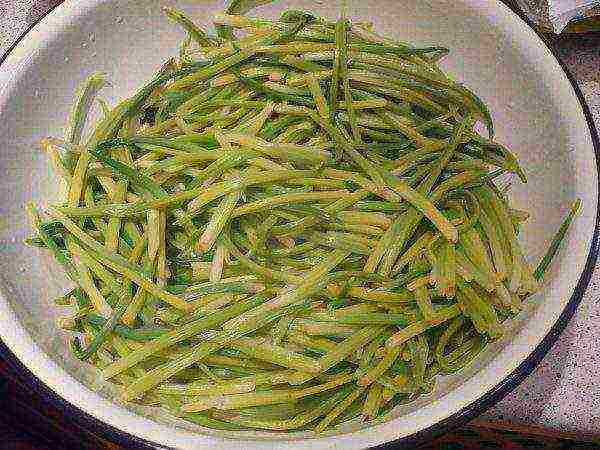 When fermented, the benefits of wild garlic practically do not suffer
When fermented, the benefits of wild garlic practically do not suffer
To always be with the harvest, it is advisable to plant wild garlic in at least three different places with an interval of one or two years. Each season, the leaves will be cut from only one garden bed, the remaining two will have the opportunity to recover.
 After flowering, the leaves of wild garlic are no longer cut off - at this time they are not so delicate and useful
After flowering, the leaves of wild garlic are no longer cut off - at this time they are not so delicate and useful
Fresh wild garlic is most useful. Leaves and bulbs are added to salads. Also, you can prepare a very tasty seasoning for meat and fish dishes from them, mixing with sour cream and chili peppers. In the Caucasian countries, the bulbs are simply eaten in bite with bread sprinkled with salt. At room temperature, the leaves will remain fresh for 4-5 days, in the refrigerator for a week or a week and a half.
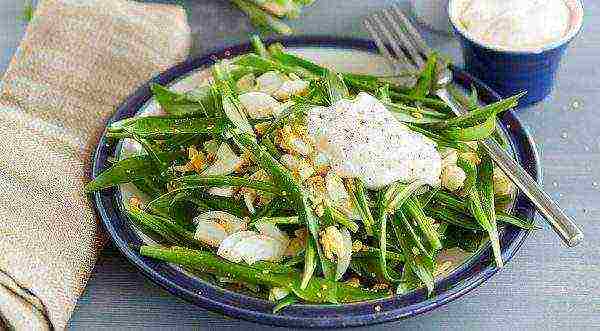 Salad with wild garlic - just a storehouse of vitamins and minerals
Salad with wild garlic - just a storehouse of vitamins and minerals
The plant is very useful for humans, but it is not recommended for feeding wild garlic. The milk changes color to reddish-yellow, the meat acquires an unpleasant aftertaste.
To preserve wild garlic for a long time, leaves and bulbs are fermented, salted, pickled. Least of all nutrients are lost during fermentation. You can freeze them. But for drying wild garlic is unsuitable. After this procedure, it almost completely loses its characteristic taste, aroma, and benefits.
 Not only leaves and bulbs are eaten, but also wild garlic flower arrows
Not only leaves and bulbs are eaten, but also wild garlic flower arrows
Video: health benefits of wild garlic
Ramson is not yet very popular among Russian gardeners. But this is completely undeserved. In spring it is practically the only fresh greens, an irreplaceable source of vitamins and minerals. The plant is very unpretentious, even a gardener without any experience is able to cultivate wild garlic on his site.
27 years old, higher legal education, broad outlook and interest in a variety of topics. Rate the article:
(1 vote, average: 5 out of 5)
